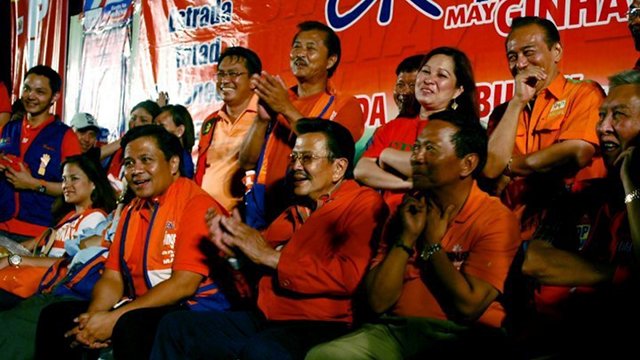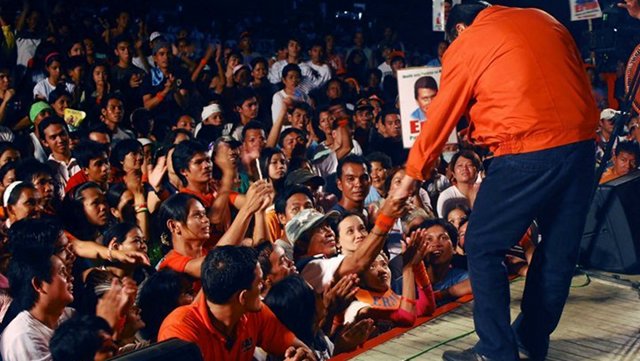SUMMARY
This is AI generated summarization, which may have errors. For context, always refer to the full article.

 FAST FACTS
FAST FACTS
Coalition for 2013: United Nationalist Alliance (UNA)
Membership: 370,000 card-carrying members*
Senate: 2 of 23
House of Representatives: 3 of 231
Local Governments: Undertermined number of governors and mayors
Chairman Emeritus: Senate President Juan Ponce Enrile
Chairman: Former President Joseph Ejercito Estrada
President: Senate Pro Tempore Jinggoy Estrada
Founded: 1991
Presidential elections won: 1998, Joseph Estrada
MANILA, Philippines – Former President Joseph “Erap” Estrada refuses to call Pwersa ng Masang Pilipino (PMP), which he founded and chairs, a political party.
It is a force, he says—“force of the masses,” to be specific. And that says a lot about where PMP draws it power, and what it brings to the table, during elections.
“Lahat ng mga political party ay partido [lang] ’pag panahon lang ng eleksiyon. Pagkatapos ng eleksiyon, sila-sila lang ang nagpapartihan, wala ang taumbayan. Kaya itong ating samahan ay hindi partido. Pwersa ng Masang Pilipino,” Estrada told his party mates at an event in May. (All the political parties are parties only during elections. After the elections, they (party leaders) divide the spoils and forget the people. That’s why our group is not a party; it is the Force of the Masses.)
In Estrada’s mind, apparently, PMP is his mass base harnessed into a political vehicle. It has yet to fail him since its foundation 2 decades ago. In fact, after Estrada’s ouster and imprisonment, party leaders said that PMP, like its founder, is bouncing back.
Political jeep ni Erap
The party started as an organization that was inspired by the Economic Recovery Action Program (ERAP) that Estrada espoused as a senator. In 1991, it was accredited as a political party, which was going carry Estrada in his planned presidential bid the following year.
Due primarily to insufficient campaign funds, Estrada agreed to be the running mate of Eduardo “Danding” Cojuangco, who was running under his own newly formed party, the Nationalist People’s Coalition (NPC). Cojuangco lost but Estrada won with a lead of 2 million votes over his closest opponent.
While the president then, Fidel Ramos, seemed to have relegated Estrada to token assignments (heading the anti-crime task force, for instance), the vice president remained so popular that his winning the 1998 presidential polls was no longer a question.
In 1998, Estrada formed the coalition Laban ng Makabayang Masang Pilipino (LAMMP), reflecting the names of the partner parties: the Laban ng Demokratikong Pilipino or LDP, the NPC, and PMP. Estrada won the presidency by a historic margin of more than 10 million votes.
During its heyday, the PMP claimed to have 3.2 million members, and LAMMP dominated Congress. The glorious years were short-lived, however. Estrada was impeached and ousted 2 years into his 6-year term, and then convicted by the graft court (but immediately pardoned by President Gloria Arroyo, his former vice president).
Navotas Rep Tobias “Toby” Tiangco, now party vice president for Metro Manila, recalled that when he joined PMP at the height of Estrada’s impeachment in 2000, friends and allies gave him this advice, “Political suicide iyan.” (That’s political suicide.)
Soon enough, Estrada was ousted in EDSA 2 in 2001. Many politicians abandoned PMP. “It was the worst time of the Pwersa ng Masang Pilipino,” Tiangco told Rappler in an interview.
Estrada’s incarceration and eventual conviction for plunder, however, did not spell the death of the party. In 2001, his wife Dr Loi Ejercito won as senator under PMP with the same number of votes that Estrada garnered in 1998. Three years later, their son Jinggoy was elected senator too, and got some 10 million votes too. It was the patriarch’s vote base at work. The former President claimed this as vindication.
A greater vindication came to Estrada and the PMP in 2010. Running for president again when the snooty elite and most of the media had dismissed him as a spent force, Estrada finished second to Benigno Aquino III—thanks to his very much intact force of 10 million voters.
“We have not only fully recovered, we are stronger than ever,” said Tiangco.

Party of the masses?
Despite the upheavals, Tiangco said one thing did not change: PMP is still the party of the masses.
“I think everyone says they’re pro-poor pero kami sa pangalan pa lang and even the ideals of the party, it’s really direkta sa masang Pilipino ang mga programa na gusto ni Presidente Estrada.” (Even the name of our party and its ideals show we are pro-poor and President Estrada really wants programs that directly benefit the masses.)
Tiangco said PMP’s populist stance is shown in the programs of the Estrada presidency, which also formed his platform for president in 2010. He said these could be summed up into food security, and peace and order.
“How are these two connected? If our farms and agriculturally rich areas are NPA-infested or there is fighting in Mindanao, you will not achieve food security. This is very important because Mindanao should really be our food basket,” Tiangco said.
As president, Estrada focused on agriculture and became controversial for declaring an all-out war against the Moro Islamic Liberation Front.
‘It’s the voters, not the leaders’
From the 3.2 million members during Estrada’s term, PMP now has only 370,000 card-bearing members, according to secretary general Simeon Garcia Jr.
The prominent ones occupy the Senate leadership: Senate President Juan Ponce Enrile and Senate President Pro-Tempore Jinggoy Estrada.
Asked about the PMP members in the House of Representatives, Tiangco joked, “Madami. Tatlo: Me, JV Ejercito and Rufus Rodriguez.”
Ejercito, son of Estrada, is congressman of San Juan while Rodriguez is from the 2nd district of Cagayan de Oro City. The party does not have an updated count of local leaders, but lists Laguna Governor ER Ejercito (Estrada’s nephew), San Juan Mayor Guia Gomez (JV’s mother), and Navotas Mayor John Rey Tiangco (the secgen’s brother) as members.
Congressman Tiangco is not worried about the party’s size, saying Estrada’s mass appeal remains a potent weapon. A February to March 2012 Pulse Asia survey showed Estrada is still a kingmaker, being the third top political endorser, next to Vice President Jejomar Binay and President Aquino.
Enrile, the party’s chairman emeritus, also fared well in recent surveys, owing to his performance as presiding judge in the impeachment trial of Chief Justice Renato Corona.
“It’s not the number of political leaders,” Tiangco said. “It’s the number of voters [they can draw]. Imagine, how can President Erap be number two [in 2010] if you base it on [the number of] political leaders?”
1992 all over again
Tiangco said membership will be easy to secure if PMP succeeds along with its decade-long coalition partner, Binay’s Partido Demokratiko Pilipino-Lakas ng Bayan (PDP-Laban).
PMP and PDP-Laban has formed the United Nationalist Alliance or UNA for the 2013 and 2016 elections. Tiangco is UNA secretary-general.
“Ang mananalong UNA sa 2013, ’di na lilipat iyan kasi may panlaban kaming presidente,” Tiangco said in reference to Binay. (The UNA candidates who win in 2013 will not switch parties because we have a presidential bet.)
For the 2013 senatorial polls, PMP is fielding Rep Ejercito and 2 new members: resigned Senator Juan Miguel Zubiri and Estrada’s long-time ally and campaign handler, former Senate President Ernesto Maceda.
There are also early talks that PMP President Senator Jinggoy Estrada might end up as Binay’s running mate in 2016.
The elder Estrada will not be left behind the scenes. The former President is running for Manila mayor in 2013 against Manila Mayor Alfredo Lim of the Liberal Party. Ironically, Lim was president of PMP but was ousted after a falling out with Estrada in 2008.
Tiangco said Estrada and PMP are upbeat about UNA. “President Estrada said it’s turning out to be exactly like the 1992-1998 phenomenon all over again.”
“In 1992, when he was voted as vice president, way before 1998, people already knew that he would be the next president. And [now] people perceive VP Binay to be the next president in 2016. You can just imagine how fast our coalition will grow.” – Rappler.com
More from #PHVote, Rappler’s 2013 Election Coverage: |
Add a comment
How does this make you feel?
There are no comments yet. Add your comment to start the conversation.